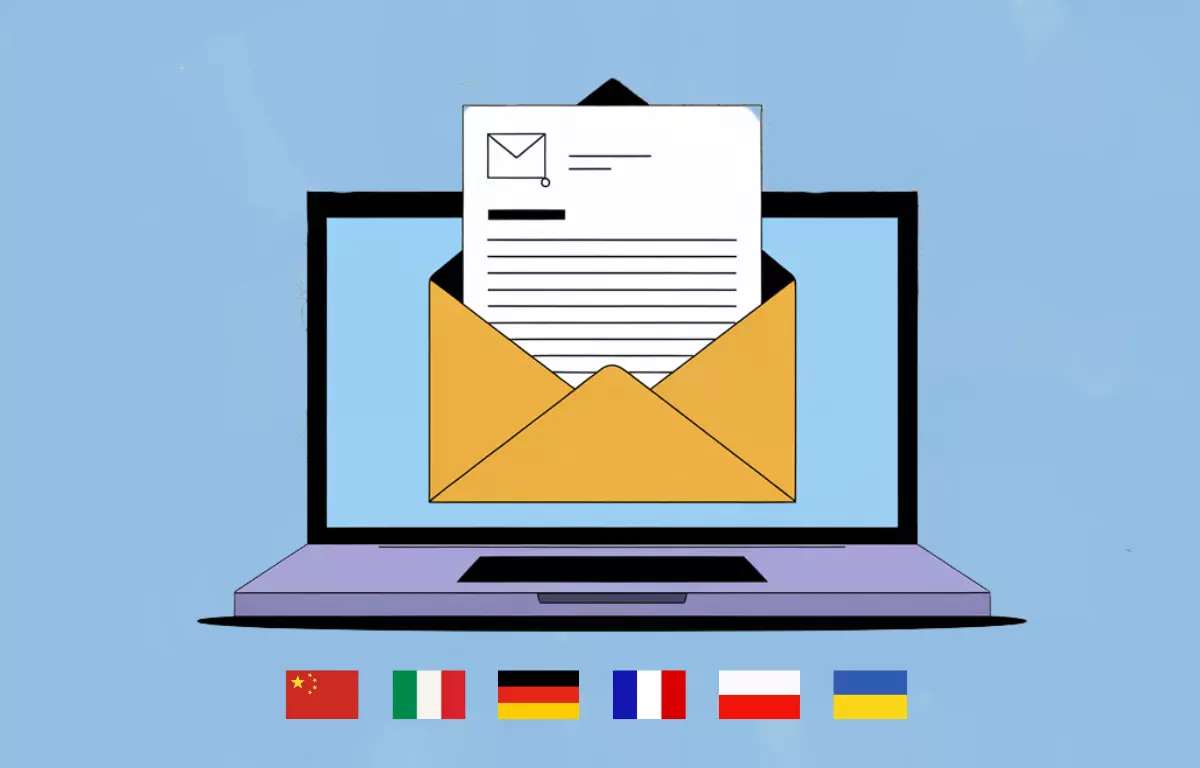Multilingual email marketing: Challenges and benefits

When your business expands beyond your country and enters the global market, it is imperative to consider how this affects all forms of communication.
This post explains the essential considerations for email marketers crafting multilingual email campaigns, from the benefits of getting it right to what challenges await them.
Benefits of using multilingual email campaigns
Before discussing the challenges that email marketers face, consider the benefits of multilingual email marketing.
Did you know that 56.2% of consumers prioritize content in their language over lower prices, with 40% refusing to purchase in a non-native language? These statistics highlight the importance of engaging customers in their language.
Here’s what you’ll gain with multilingual email marketing campaigns:
- Growth in the number of customers or users in different countries.
- Trust from customers upon seeing your emails in their native language.
- The ability to stand out from the competition by delivering a more personalized approach to potential customers.
- More reasons for your sales email campaigns thanks to new cultures and audience habits.
- Higher open rates and product sales.
The essentials of localizing emails
Email localization concerns the translation of emails into different languages and the observance of traditions, holidays, and the cultural context of the country where the recipient is located.
Simply translating emails is insufficient. Even if all your customers speak English, a single approach to a specific email message won’t be appropriate for audiences in the USA, Canada, Australia, and the UK. For instance, Canadians and those in the UK expect Christmas emails to feature snowy scenes, but such imagery would be irrelevant for Australians experiencing summer during that time.
However, it’s critical to know more about the recipient’s country than the weather patterns. For example, one in five Americans doesn’t speak English at home, and six countries, such as Belgium and Switzerland, have at least two official languages.
Therefore, to properly localize email campaigns, it’s essential to be aware of the following:
1. Language nuances
Accurate translations are paramount. Collaborating with experienced translators or agencies familiar with industry-specific language nuances is essential. Consider the terms and expressions used in each particular region. Machine translation tools can also be a starting point, but human postediting is crucial.
2. Cultural differences
Email content must resonate with the cultural values and customs of each region. For example, the dates of some holidays may differ. The beloved Mother’s Day is celebrated by Americans in May, while residents of Great Britain celebrate it in March. Holiday traditions are also different in these countries. Even email communication styles may differ, with some regions preferring formal to informal tones.
3. Relevance of visuals
Visual content should mirror the cultural and environmental context of the target audience. For example, when preparing Christmas email campaigns for different countries, consider that Christmas is associated with snow in some places, while in others, such as Australia, New Zealand, and some states in the USA, it is not.
4. Units of measurement
With regions adhering to varied measurement systems, such as imperial or metric, localizing such content is essential to preclude misunderstandings. For example, the sign denoting currency is placed before or after the amount and the writing of large numbers differs depending on the country. In the USA, Canada, and Great Britain, 1 million is written as 1,000,000, while in some countries in Europe and Latin America, it is written as 1.000.000.
5. Date format
Dates can be written differently in different regions. In Europe, 25 December of this year is written as 25/12/2024, while in the USA, it is formatted as 12/25/2024. If you need to include an exact date in an email, be careful not to confuse your subscribers.
6. Consistency
Another challenge is ensuring consistency across multiple languages. Providing comprehensive style guides, glossaries, and contexts to translators can ensure cohesive messaging across campaigns.
7. Technical compatibility
Languages that are read from right to left, such as Arabic and Hebrew, require special attention. Adopting universal character encoding and staying abreast of technological advancements will ensure that emails are displayed correctly.
8. Regulatory compliance
When using email marketing in different countries, companies should remain current on the specifics of data collection regulations, privacy policies, anti-spam laws, and advertising regulations. Monitor local laws and adjust email marketing methods and email content to ensure compliance.
9. Current situation
Global events, whether they are socio-political upheavals or public health crises, influence how recipients perceive your emails. During significant events, such as earthquakes, promotional emails might appear insensitive. However, positive occurrences, such as a country’s victory in a sports competition, provide an opportunity to align content with prevailing sentiments.
Challenges that email marketers face when running multilingual email campaigns
The main challenges associated with multilingual email marketing are related to preparing the email address base, email production, and interpretation of campaign results.
Preparing a contact list
The first point of focus is collecting relevant information for personalization. Simply ask your customers about their language preferences and in which country they reside.
According to statistics, 83% of customers are happy to share their data for a personalized experience (Forbes). You can also use Google third-party cookies to track which language version your website audience uses.
Next, create audience segments and use the automation and segmentation capabilities of your ESP or CDP to customize emails according to the information you’ve collected, as follows:
- In the required language.
- Considering the cultural peculiarities of the country.
- At a good time—considering the recipient’s time zone so that emails do not arrive late at night.
In addition to segmentation, you can also use localization methods, such as dynamic content, which allows you to include all the necessary language versions in the email, and scripting to incorporate translations, enabling the delivery of emails in the required language.
Email production
Preparing emails with language differences and other aspects in mind increases the time spent on email production. Therefore, you will need to change the email production flow and add localization for each language after preparing the email.
In email production, localization usually includes the following stages:
- Translate and adapt the finished email into all languages using services or a translator.
- Prepare a new visual, if necessary.
- Create an email layout for all language versions in the email editor—different language versions must look equally beautiful in all blocks of the email, given that the text size may change due to the peculiarities of the language.
- Ensure that you have translated all parts of the email—the subject line, body, footer, banners, alt text for images, and buttons.
- Test email links to ensure that they lead to the correct language versions of the website.
- Test all language versions.
Results of email campaigns
You may see different email marketing performance metrics in other countries. The difference in performance may be due to various factors. For example, the popularity of specific industries may vary in different countries, and people may have different perceptions of branded email communications. The differences between regions may be significant, so you need to be patient and test email campaigns.
Tools to reduce time spent on multilingual email marketing
To accelerate your work when localizing email campaigns, use tools that help you at every stage of creating and sending emails.
What to consider when choosing tools for creating email marketing campaigns for multiple languages and countries:
- Content localization services. These are online translators or companies that provide a cloud-based translation management system and real-time collaborations with translators.
- Proofreading services. Sites such as Grammarly allow you to check texts quickly and efficiently.
- An email builder designed with localization needs. For example, content blocks can be tailored to different audiences within one email, allowing easy swapping of localized text and images, and dynamic content integration ensures that users from different regions can see relevant content.
- ESP or CDP with localization-friendly features. These can include the following:
- Audience segmentation by region and language, dynamic content, or scripting. You create one email in many languages, and when sending the email, the ESP, knowing the client’s language, substitutes texts and images in the required language.
- Time zone optimization to ensure that emails are sent at the most effective time in each country.
- A/B testing capabilities for different language variations.
You can also accelerate the content localization process by adding AI-powered tools to your arsenal. GenAI tools like ChatGPT are great for writing, translating, and adapting email content to different cultural contexts and situations. They can also check your content (both text and visual) for cultural relevance.
Conclusion
As you can see, preparing email marketing campaigns for a global audience includes challenges and opportunities. Email localization allows you to communicate with users on a deeper level to improve their experience and achieve better results for your business. Using the recommendations in this article will enable you to localize your email campaigns and overcome the difficulties of multilingual email marketing.
